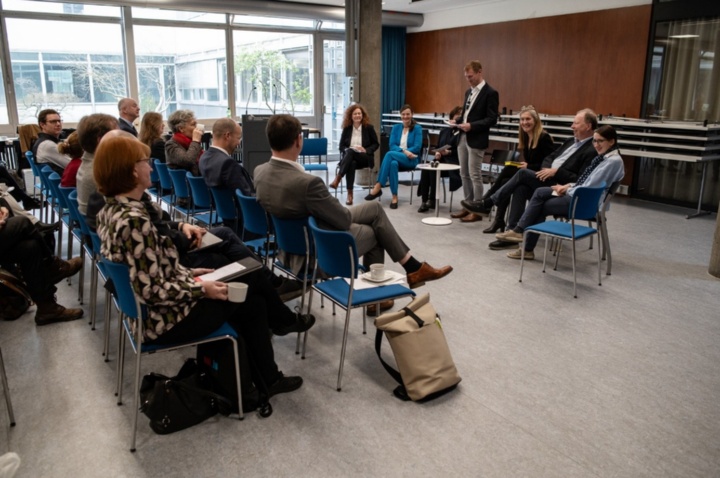A future workshop at Stuttgart University Library is crafting a vision for a joint library serving all of Stuttgart's universities in the city center. The previously separate libraries of the University of Stuttgart, the Baden-Württemberg Cooperative State University (DHBW) and the University of Applied Sciences (HFT) are to be united under one roof to form the Campus HUB, with the addition of many contemporary functions of modern academic facilities.
The workshop was held on March 15, 2024, at the university library. It brought together people involved from the fields of science, administration and politics to discuss a concept for the organizational and architectural redesign of the university library. This redesign is imperative due to limitations imposed by the aging listed building, which currently can only be partially used following a cable fire. Urgent renovation is required to restore its functionality. Campus-HUB stands for Campus Hochschul- und Universitäts-Bibliothek.
Uniting separate libraries in one building
The concept, as presented by Vice Rector Simone Rehm in her welcoming address and Director of the University Library Helge Steenweg in his opening statement, is as straightforward as it is captivating: Three neighboring universities merge their formerly separate libraries into a single facility, pooling resources to establish a cutting-edge science center. Innovative learning spaces will be available at a central location in Stuttgart and research findings and materials will be stored and used - analog, digital and spatially networked. This facility will serve as a hub for conferences, scientific training, and public events, facilitating collaboration among individuals, projects, and resources. It will be a dynamic center where knowledge is generated, discussed, refined, exhibited, and tested - a flagship university venue for science communication and knowledge exchange.
Inspired by three keynote speeches highlighting recent advancements in the construction and organization of academic facilities, the participating institutions deliberated on their expectations for decision-making bodies and explored implementation possibilities, occasionally stirring controversy. However, it is not feasible to implement these ideas without significant structural development measures in the city park vicinity.
There was a general consensus regarding the position expressed by the chair of the student body. In reference to the current state of the partially closed library, Anna Dannecker remarked, "The existing learning spaces are far from ideal. There is no direct access to books, and the ambiance is nothing like that of a reading room." Julia Bergmann, an information and knowledge transfer consultant from Bremen, echoed this sentiment, stating, "Individuals visit the library to 'suffer' together within a community of peers." Students arrange to go to the library like 'we're all going to the gym together'. This helps many people to work better." The slogan "Learning spaces are tools for thinking" shows that a "data laboratory" is just as much a part of a library today as the manuscript reading room once was.
Added value for the Stuttgart science landscape
The Rector of the University of Stuttgart, Wolfram Ressel, expressed hope that the synergistic effects resulting from the merger of the libraries and academic institutions of the three universities would enhance Stuttgart's academic landscape. This sentiment was met with approval by the Rectors of HFT and DHBW Stuttgart, Katja Rade and Beate Sieger-Hanus. Beate Sieger-Hanus in particular, whose institution is spread across numerous locations in the city center, emphasized the need for an intellectual center for the universities, and Katja Rade explained: "It's about improving the spatial situation, especially for students, and providing new innovative learning spaces, not so much about saving space and resources".
The question of whether and how the plans for the Campus HUB can be fully realized, considering the additional space required in the foreseeable future, needs to be clarified. Veronika Kienzle, head of the Stuttgart Mitte district, emphasized the function of the city park as a recreational area and green lung in the city center. There was agreement that the additional construction volume would have to be achieved by saving and reusing space elsewhere. In addition, the necessary renovation of the university library on the city center campus should not be delayed by the far-reaching plans. It became clear that a joint facility for the three universities in the existing university library building alone would not be feasible. The first step is for the University Building Authority to measure the required space and plan the renovation of the existing building so that the necessary renovation funds can be made available by the state as soon as possible.


